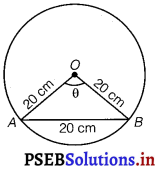Punjab State Board PSEB 11th Class Maths Book Solutions Chapter 3 Trigonometric Functions Ex 3.1 Textbook Exercise Questions and Answers.
PSEB Solutions for Class 11 Maths Chapter 3 Trigonometric Functions Ex 3.1
Question 1.
Find the radian measures corresponding to the following degree measures:
(i) 25°
(ii) – 47° 30′
(iii) 240°
(iv) 520°
Answer.
(i) 25°
We know that: 180° = π radian
∴ 25° = \(\frac{\pi}{180}\) x 25 radian
= \(\frac{5 \pi}{36}\) radian
(ii) – 47° 30′
-47° 30′ = 47 \(\frac{1}{2}\) degree
= \(-\frac{95}{2}\) degree
Since 180° = π radian
\(-\frac{95}{2}\) degree = \(\frac{\pi}{180}\) × \(-\frac{95}{2}\)
= \(\left(\frac{-19}{36 \times 2}\right)\) π degree
= \(-\frac{19}{72}\) π radian
∴ – 47° 30′ = \(-\frac{19}{72}\) π radian.
![]()
(iii) 240°
We know that: 180° = π radian
∴ 240° = \(\frac{\pi}{180}\) × 240
= \(\frac{4}{3}\) π radian.
(iv) 520°
We know that: 180° = π radian
∴ 520° = \(\frac{\pi}{180}\) × 520 radian
= \(26 \frac{\pi}{9}\) radian
Question 2.
Find the degree measures corresponding to the following radian measures. (Use π = \(\frac{22}{7}\))
(i) \(\frac{11}{16}\)
(ii) – 4
(iii) \(\frac{5 \pi}{3}\)
(iv) \(\frac{7 \pi}{3}\)
Answer.
(i) \(\frac{11}{16}\)
We know that: π radian = 180°
∴ \(\frac{11}{16}\) radain = \(\frac{180}{\pi} \times \frac{11}{16}\) × degree
= \(\frac{45 \times 11}{\pi \times 4}\) degree
= \(\frac{45 \times 11 \times 7}{22 \times 4}\) degree
= \(\frac{315}{8}\) degree
= 39 \(\frac{3}{8}\) degree
= 39° + \(\frac{3 \times 60}{8}\) minutes [1° = 60′]
= 39° + 22′ + \(\frac{1}{2}\) minutes
= 39°22’30” [1′ = 60°].
![]()
(ii) – 4

(iii) \(\frac{5 \pi}{3}\)
We know that : π radian = 180°
∴ \(\frac{5 \pi}{3}\) radian = \(\frac{180}{\pi} \times \frac{5 \pi}{3}\) degree = 300°
(iv) \(\frac{7 \pi}{6}\)
We know that : π radian = 180°
∴ \(\frac{7 \pi}{6}\) = \(\frac{180}{\pi} \times \frac{7 \pi}{6}\) = 210°.
Question 3.
A wheel makes 360 revolutions in one minute. Through how many radians does it turn in one second?
Answer.
Number of revolutions made by the wheel in 1 minute = 360
∴ Number of revolutions made by the wheel in 1 second = \(\frac{360}{6}\) = 6
In one complete revolution, the wheel turns an angle of 2π radian.
Hence, in 6 complete revolutions, it will turn an angle of 6 × 2π radian, i.e., 12π radian
Thus, in one second, the wheel turns an angle of 12π radian.
![]()
Question 4.
Find the degree measure of the angle subtended at the centre of a circle of radius 100 cm y an arc of length 22 cm (Use π = \(\frac{22}{7}\)).
Answer.
We know that in a circle of radius r unit, if an arc of length l unit subtends an angle θ radian at the centre, then θ = \(\frac{l}{r}\)
Therefore, for r = 100 cm, l = 22 cm,
we have

Thus, the required angle is 12°36′.
Question 5.
In a circle of diameter 40 cm, the length of a chord is 20 cm. Find the length of minor arc of the chord.
Answer.

Given, diameter = 40 cm
∴ radius (r) = \(\frac{40}{2}\) = 20 cm
and length of chord, AB = 20 cm
Thus, ∆OAB is an equilateral triangle.
We know that,
θ = \(\frac{\text { Arc } A B}{\text { radius }}\)
⇒ Arc AB = θ × r
= \(\frac{\pi}{3}\) × 20 .
= \(\frac{20}{3}\) π cm.
![]()
Question 6.
If in two circles, arcs of the same length subtend angles 60° and 75° at the centre, find the ratio of their radii.
Answer.
Let the radii of the two circles be r1 and r2.
Let an arc of length l subtend an angle of 60° at the centre of the circle of radius r1, while let an arc of length l subtend an angle of 75° at the centre of the circle of radius r2.
Now, 6o° = \(\frac{\pi}{3}\) radian and
75° = \(\frac{5 \pi}{12}\) radian
We know that in a circle of radius r unit, if an arc of length l unit subtends an angle θ radian at the centre, then θ = \(\frac{l}{r}\) or l = rθ
∴ l = \(\frac{r_{1} \pi}{3}\) and
l = \(\frac{r_{2} 5 \pi}{12}\)
⇒ \(\frac{r_{1} \pi}{3}=\frac{r_{2} 5 \pi}{12}\)
⇒ r = \(\frac{r_{2} 5}{4}\)
\(\frac{r_{1}}{r_{2}}=\frac{5}{4}\)
Thus, the ratio of the radii is 5 : 4.
![]()
Question 7.
Find the angle in radian through which a pendulum swings if its length is 75 cm and the tip describes an arc of length
(i) 10 cm
(ii) 15 cm
(iii) 21 cm.
Answer.
We know that in a circle of radius r unit, if an arc of length l unit subtends an angle θ radian at the centre, then
θ = \(\frac{l}{r}\).
It is given that r = 75 cm
(i) Here, l = 10 cm
θ = \(\frac{10}{75}\) radian
= \(\frac{2}{15}\) radian
(ii) Here, l = 15 cm
θ = \(\frac{15}{75}\) radian
θ = \(\frac{1}{5}\) radian
(iii) Here, l = 21 cm
θ = \(\frac{21}{75}\) radian
= \(\frac{7}{75}\) radian.
